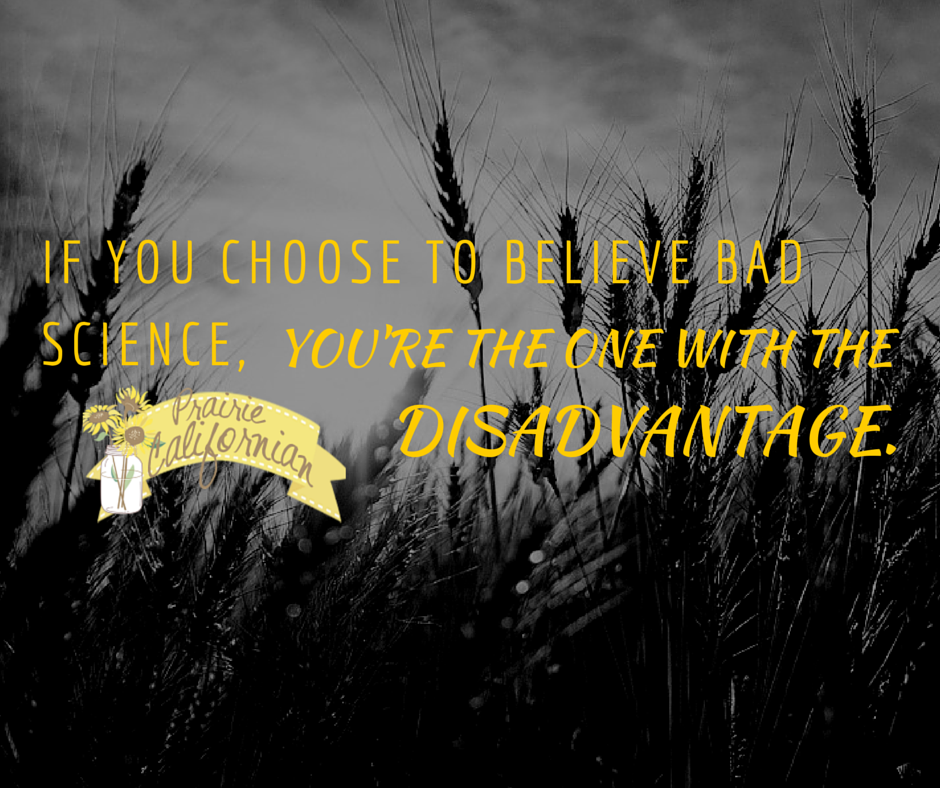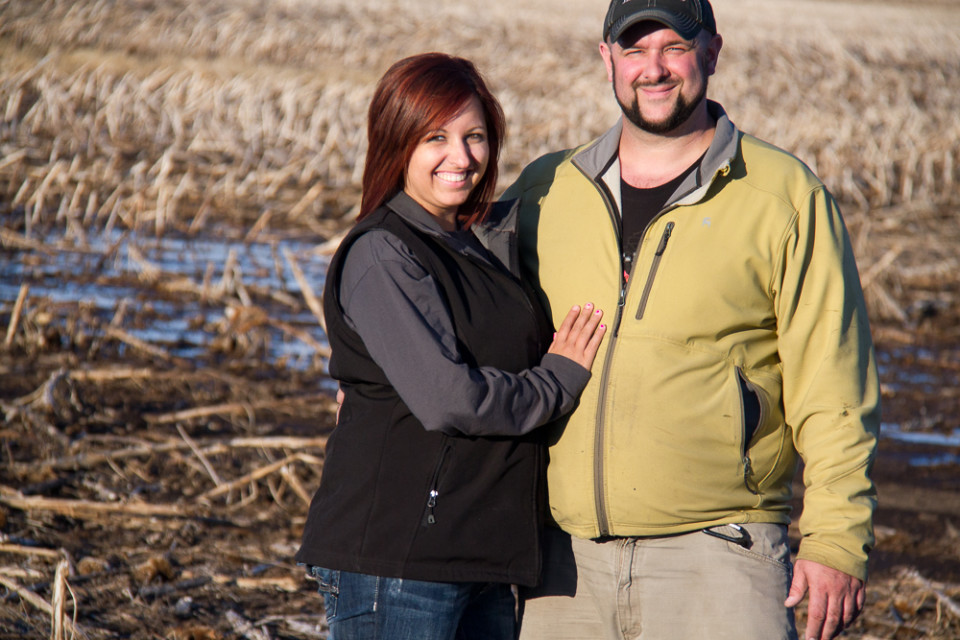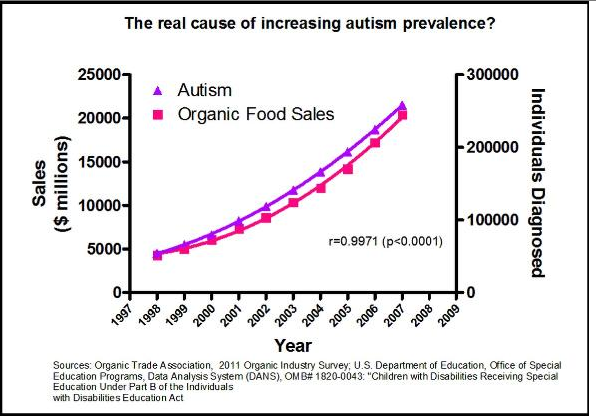
** title inspired by Julie Gunlock **
Ever since I wrote my post about The Truth Behind Toxic Wheat, I regularly get emails in my inbox of people wanting to engage me in “friendly discussion” and then proceed to tell me that I am the root of all evil simply because we use glyphosate on our farm. And it leaves me sort of scratching my head, huh… If you read that post, you should conclude that glyphosate is a fairly non-toxic herbicide. So why the continued spreading of fear surrounding it?
Well, apparently they aren’t the only ones continuing this fear surrounding glyphosate. There has been this new viral article making the rounds and quite frankly scaring the bejesus out of already tired and overly judged moms out there. It is entitled “Glyphosate Herbicide Will Cause Half of All Children to Have Autism by 2025“… Sounds scary, right?
Well it doesn’t have to be. While I could continue to speak out on the safety of glyphosate, I’ve already done that. Instead I want to talk about this continued choosing to believe bad science when it comes to our food.
This “research” was done by Dr. Stephanie Seneff who has a scientific rap sheet a mile long — just google “Seneff debunked” to check it out. Seneff is a senior research scientist at the computer science and artificial intelligence lab at MIT with degrees in biophysics and electrical engineering. Why an electrical engineer is researching pesticides is beyond me, but the scientific community agrees on one thing.
Seneff does zero original research. Instead, Seneff cherry picks any information that fits her hypothesis. While this “research” done by Seneff is certainly compelling, it is the opposite of how science is done.
We all know how easy it is to find information to support our hypothesis versus letting the data support or refute our hypothesis. Science isn’t believing that correlation equals causation. And if that were the case, the graph below would be indeed true.
If you’ve followed me for any amount of time, you know how passionate I am about our food system: finding out both how food is grown and where food comes from. I love to celebrate our beautiful and complex system that provides us with a wealth of food. And I understand that navigating that food system can be hard. But why in the world do we turn to computer scientists like the Food Babe or Stephanie Seneff to tell us how our food is made when we’ve got people like farmers or scientists who are living and researching these issues day in and day out?
My husband is third generation on our farm and we farm the land that his grandfather originally settled along with his father and brother. It is just the three of them along with their wives. We farm wheat, corn, soybeans, and sunflowers. These seeds we purchase from a variety of companies like Monsanto, Dow, and some regional seed companies. Some of the crops we grow are GMO (corn and soybeans) and some aren’t (sunflowers and wheat). We do indeed use crop protection products like herbicides, fungicides, and insecticides. We sell our grain commercially, meaning we don’t grow anything we sell direct to consumers. That is what we do, in a nutshell.
 Now by Seneff’s definition, we are everything that is wrong with the food supply. We are the bad guys. We are criticized of poisoning our food, the environment, and now giving children autism.
Now by Seneff’s definition, we are everything that is wrong with the food supply. We are the bad guys. We are criticized of poisoning our food, the environment, and now giving children autism.
But are we?
Yet here I am. Writing to you, writing for you. Spending hours of my free time (and some paid time at my day job) breaking down concepts in agriculture, answering emails, commenting on Facebook, engaging on Twitter, posting on Instagram. I don’t get paid to do these things, I do them because I love agriculture and I know how important EACH AND EVERY part of it is to our lives. From the organic farmers, to the local farmers, to the conventional farmers like us. I am being honest and upfront about what we do on our farm, I am not lying or trying to hide any part of it. And I don’t believe with any facet of my being that what we do on our farm is wrong or dangerous.
And while we are being honest and up front, let me tell you, it hurts to know that people call what we do evil.
So I say this next sentence with the most sincerity in my heart. If you choose to use bad science to support your claims or simply refuse to believe evidence-based science, you’re the one at a disadvantage. Making choices to provide your family with healthy meals does not have to be that hard or require going to advance lengths to acquire. We live in this day in age where modern convenience makes acquiring food the easiest it has ever been.
Want to know who had it hard? Our ancestors. I am thankful that I don’t have to spend my summers foraging, canning, pickling, and preserving foods like my husband’s ancestors did here in North Dakota simply so they could survive through the winter. Sure, I love to can and pickle. But I don’t require it to survive. Instead I can purchase strawberries from California in the middle of winter in North Dakota. And that my friends is a thing of beauty!
My point here is that, let’s spend our time supporting the beauty of choice that is provided to us in our food system rather than vilifying the very industry that makes those choices available to us. I know in my book it is never okay to promote that conventional methods of farming is going to cause someone’s child to develop autism.
There is bad science that is peddled by people like the Food Babe, Dr. Oz, and the lovely Miss Seneff and there is peer-reviewed, evidence-based science that is endorsed by the medical and scientific communities which continues to be put to the test and reviewed.
Which one will you choose?
For Resources on Glyphosate and Autism, check out these links
Cooper, J. (2014). Autism Not Increasing.
Cooper, J. (2014). Bogus Paper on Roundup Saturates the Internet.
Folta, K. (2013). Maybe GMO’s Aren’t the Problem.
Hall, E. (2013). Roundup, Gut Bacteria, and Bad Science Reporting.
Haspel, T. (2013). Condemning Monsanto with Bad Science is Dumb.
Katiraee, L. (2014). Is there evidence supporting a link between autism and Gmos?
Kloor, K. (2012). When Bad News Stories Help Bad Science Go Viral.
Kniss, A. (2014). Salt, Vinegar, and Glyphosate.
Novella, S. (2014). Autism Prevalence Unchanged in 20 Years.
Rohrich, J. (2014). What are Pesticides and Why Do We Use Them?
Rohrich, J. (2014). The Truth Behind Toxic Wheat.
Schultz, S. (2014). The Truth About Glyphosate and Wheat.
Skeptical Raptor. (2014). Agricultural pesticides cause autism? Don’t hold your breath.



Jenny, thank you so much for this wonderful article, and I just had to comment to make sure that you got some support. I found your article through “The Farmer’s Daughter” on FB. As someone who used to buy organic because of some vague fears (not fanatical about it, just kind of did it whenever I could), but who took the time to “do my own research,” LOL I have been greatly reassured about the safety and quality of our food system in the USA. I no longer bother buying organic, I have no worries about Round-up Ready crops, am perfectly comfortable with GMOs, and sadly had to ban one of my own cousins on FB after learning that she thinks Monsanto is worse than the Nazis.
Anyway – well done article. 🙂 I’ll look forward to future ones, too.
Good job, again. Especially impressive is the resource list.
Thank you! Great post!
You are so good with words, Jenny. I was so excited to see The Farmers Daughter post your article. I’m so appreciative of what you two do to get the real science and the truth out there for consumers.
Such a great article, Jenny! Thank you for taking the time to write it and for putting yourself out there and not being afraid to share your story. Also, thank you for all the hard work you do as farmers! I feel so fortunate to have hardworking, passionate, and dedicated farmers like you growing our food.
Don’t be too hard on us computer scientists. We deal in artificial intelligence. Being married for 40 years to a fourth generation farmer and with a son who sells GM seed, I also try to steer people to the truth about glyphosate and GMOs. I recently had an exchange with the Juice Lady after she sent out an email to her subscribers about children being autistic due to 97% of wheat being drenched in glyphosate. I politely showed her where the same government website where Stephanie Seneff got her 97% figure (http://www.nass.usda.gov/Newsroom/Notices/05_15_2013.asp), which really said that herbicides in general are used on 97% of wheat, also indicated that glyphosates are used on a very small percentage of wheat if you drilled down to the wheat information (http://www.nass.usda.gov/Surveys/Guide_to_NASS_Surveys/Chemical_Use/2012_Wheat_Highlights/index.asp). I really hoped she was interested in the truth, so I was pretty disappointed when she deleted all my posts so no one else could see the truth either. I can understand people not feeling comfortable with GMOs, even though that seems silly to me. I can not understand people who insist on believing lies when they are shown the truth.
Sorry. spoke before I thought. Actually although the article mentioned that half of all children would be autistic by 2015 because of glyphosates, that was just a side comment. The article was actually about gluten intolerance and celiac disease really not being caused by gluten at all but by glyphosates, since “97% of all wheat is drenched in glyphosate”. Regardless, the result was the same. Sadly, anyone with celiac disease who believes that “science” and thinks it is safe to eat bread made from organic wheat is in for a rude awakening. By the way, love your blog. I have used some of your facts when I’ve talked to people.
Thank you for your comments and the links, Diana. I had wondered where those tables came from, but hadn’t found the correct link. USDA’s data at the second link you posted contains a table (Table 1) that lists the most common herbicides used on the different wheat types (winter, spring [exc. durum], and durum) they surveyed. The asterisked note at the bottom of the table is worth noting. It is an explanation of how USDA views “Crop Year” for the terms of their survey. The note defines the Crop Year as, “The period immediately after harvest of the previous year’s crop and ending at harvest of the current year’s crop.” It is important to note that with this definition, herbicides applied during the fallow period, when no crop is actively growing, are also included in the total. In my area, NE Oregon, we fallow for an entire year between crops to collect enough moisture to grow a decent crop. Our rainfall comes mainly in the Fall and Winter. It is very common to use glyphosate to kill weeds and volunteer wheat plants during this fallow period. Virtually all of the glyphosate used in this area is applied in this manner. Failure to understand the nature of the data collection is another of the flaws in the naysayers thought process.
Good article, Jenny. Stephanie Seneff first came to my attention several years ago when she came out with a paper blaming autism on the aluminum found in some vaccines. It was a terrible word salad of an article. On her MIT website, she still lists papers and presentations in 2014 that link vaccines and autism. How she can hold two wildly different and conflicting causes for autism without the cognitive dissonance making her head explode is anyone’s guess.
Don’t be too hard on us computer scientists. We deal in artificial intelligence, not real intelligence. Being married for 40 years to a fourth generation farmer and with a son who sells GM seed, I also try to steer people to the truth about glyphosate and GMOs. I recently had an exchange with the Juice Lady after she sent out an email to her subscribers about children being autistic due to 97% of wheat being drenched in glyphosate. Her information came from Stephanie Seneff. I politely showed her where the same government website where Stephanie Seneff got her 97% figure (http://www.nass.usda.gov/Newsroom/Notices/05_15_2013.asp), which really said that pesticides in general are used on 97% of wheat, also indicated that glyphosates are used on a very small percentage of wheat if you drilled down to the wheat information (http://www.nass.usda.gov/Surveys/Guide_to_NASS_Surveys/Chemical_Use/2012_Wheat_Highlights/index.asp). I really hoped she was interested in the truth, so I was pretty disappointed when she deleted all my posts so no one else could see the truth either. I can understand people not feeling comfortable with GMOs, even though that seems silly to me. I can not understand people who insist on believing lies when they are shown the truth.
By the way, love your title and your blog in general. I’ve made use of your information more than once.
Jenny, I always enjoy your posts and look inside your family farm. I know farming is HARD work and you do such a good job promoting respect towards all different kinds of operations! I wish you would get the same respect you show others. Excited to see your merch for sale 🙂 Look forward to keeping up with you all in 2015!!